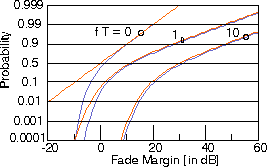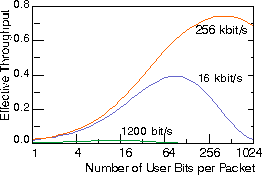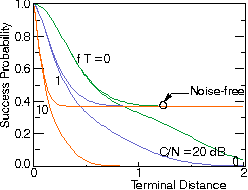
 |
www.WirelessCommunication.NLChapter: Wireless Propagation Channels
|

Figure: Probability that a packet is received without fade in a (frequency nonselective) Rayleigh fading channel
versus fade margin. Orange: single Rayleigh fading interferer, no noise. Violet: Many weak interferers or Gaussian Noise. Various data block or "packet" durations T, relative to Doppler spread f.


Figure: Effective Throughput of fade-free packets in a (non-selective) Rayleigh fading channel, as a function of number of bits (48 header bits not included) in a packet for bit rates of 1200; 16k and 256 kbit/s. Doppler spread 60 Hz. Fade margin 10 dB.

 Packet length and rate of fading
Packet length and rate of fading Slow versus fast fading. Role of error correction
Slow versus fast fading. Role of error correctionFast bit rates ensure good throughput: Most packets are successful, but some are lost in fade. With slow transmission rates on the other hand, all packets are likely to contain one or more bursts of errors, so virtually all packets may be lost.
Note however, that with increasing bit rates, channel dispersion becomes a problem.